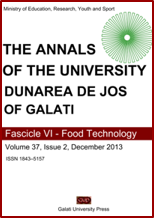A comparison of nitrate level in spinach grown both under different densities in aquaponic system and under natural growth conditions
Abstract
As bio-integrated systems that link both plants and fish culture, inside aquaponic systems, the processes of ammonia-oxidizing and nitrification in nitrite and nitrate are essential for growth and development of both fish and plants culture biomass. Plants with nearly the same nutritional requirements during their life cycle, like spinach in our case, are recommended to be grown under aquaponic conditions. Although nitrates concentrations up to 200 – 250mg/l are reported to be acceptable for fish growth, in the last years the toxic effect of long term exposure to high nitrate levels on fish and plants cultured biomass were highlighted. The main goal of the present study is to compare the nitrate level of spinach, grown in an aquaponic system, under three plant densities (V1 - 59 plants/m2, V2 - 48plants/m2 and V3 – 39 plants/m2). The second objective is to compare the results obtained, in term of nitrate content, for spinach grown in the integrated rainbow trout –
spinach aquaponic system with those of marketable spinach, grown under conventional condition, in the field. The experimental design consists in a recirculating aquaculture system with 12 growing units, mechanical and biological water treatment units and four aquaponic units. Fish were fed with two types of feed with 41% and 50% protein, using 3 different feeding regimes. The results show a higher nitrate level on spinach grown in aquaponic system, compared to the one derived from field culture. Differences were observed also among the three variants grown in aquaponic conditions, under different plant densities. As a conclusion, it can be said that considering the nitrate level, spinach grown in aquaponic system is marketable.


